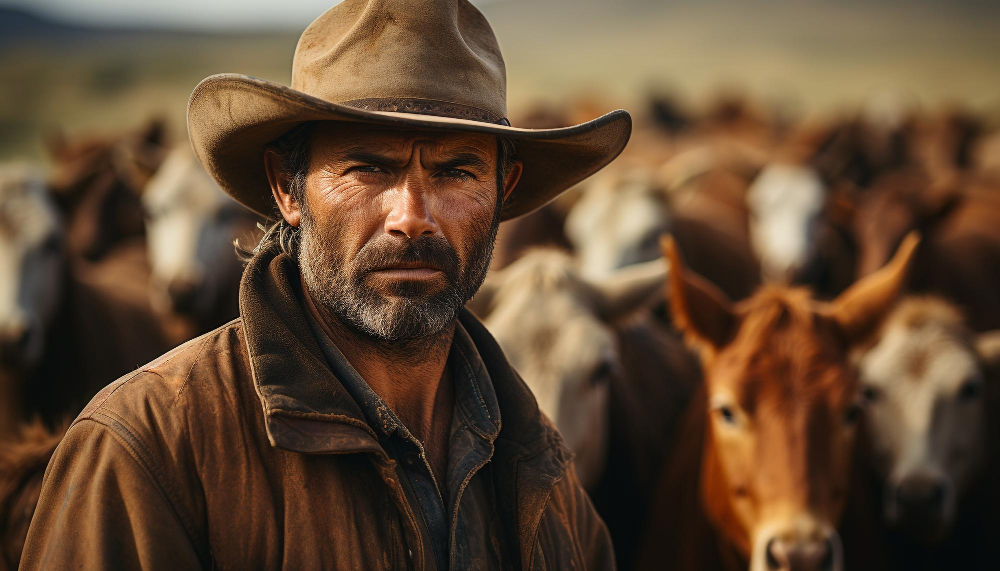As the wolf population rebounds in the American West, cattle drovers are going to extreme measures to attend with the fabulous bloodsuckers.
In the fall of 2014, when the Elzinga family of Alderspring Ranch were bringing their cattle back to the estate from the jagged swash defiles and rocky peaks of their public grazing allotment above Idaho’s Salmon River Corridor, they discovered 14 of their creatures were missing.
Despite riding 30 to 50 long hauls on horseback four to five days a week to check on their herd, the Elzingas had lost$ 35,000 of profit to bloodsuckers.
utmost of the signs refocused to wolves.
That time, biologists had proved 104 packs within the state as well as another 23 along its borders.U.S. Fish and Wildlife Service verified canids had killed 136 cattle and 114 lamb across the Northern Rocky Mountain countries of Idaho, Montana and Wyoming.
commodity had to change if Alderspring Ranch was going to stay in business. “ We were licking our injuries, ” says owner Glenn Elzinga, a logger by trade, who had been ranching for further than 20 times. “ We came off that experience like we ’re not going back — that’s profitable self-murder. ”
Ever since the reintroduction of argentine wolves in Yellowstone National Park nearly 30 times agone , drovers across the West have been forced to find ways to cover their beast from the apex bloodsuckers. numerous might prefer the three Ss( “ shoot, shovel and shut up ”). Others, similar as the Elzingas, have set up nonlethal styles for concurrence.
According to some estimates, overhead of two million wolves may have formerly floated North America. But a civil decimation program in the US, aimed at helping white settlers cover beast, brought them to the edge of extermination by themid-20th century. With the rise of the environmental movement and the establishment of the Exposed Species Act in the 1970s, a two- decades-long trip toward restoring wolf populations in Yellowstone National Park and Central Idaho began. Studies in Yellowstone have shown that wolves have likely contributed to willow and aspen recovery, along with overall niche diversity.
ADS
The issue of wolf recovery and reintroduction has been bending pastoral coproprietors against civic wildlife lawyers ever ago, and it’s about to hit another corner latterly this time.
Right now, the State of Colorado is working on a argentine wolf reintroduction plan that passed a ballot measure in 2020. Those wolves, which are slated to be brought back to the state’s Western pitch this time, will be defended under state and civil laws( state lawgivers are presently trying to work out to what extent). This means Centennial State drovers will be fairly obliged to find nonlethal means of dealing with wolf predation. California, Washington and Oregon boast analogous protections for wolves.
The ways used by Alderspring Ranch could help.
Back to the range
A many months after lamenting their losses, Elzinga set up himself at a neighbor’s house esteeming an idyllic turn– of- the- centuryC.M. Russell oil of cowhands boarding on the range with their cattle. The horsewoman had long been a addict of the buckaroo artist’s work, but commodity about this particular image struck him. He got into his truck, turned to his woman Carol and asked, “ Why ca n’t we just live on the range with our cattle like those guys did? ”
Soon, Elzinga discovered a book entitled The Art & Science of Shepherding that explores the ancient ways of French herdsmen. It set him down a path toward what he now calls “ inherding. ” He and his crew, which includes his factory ecologist woman , seven daughters and sprinkle of interns, stay with their cattle24/7 for their entire summer grazing period.
brigades of at least three people go out for four- day stints, driving their 400 to 500 yearlings down from sensitive riparian areas and poisonous shops and toward lush highland meadows. This helps to help corrosion in critical aqueducts that give niche for salmon and beavers while perfecting soil health and allowing native meadows to thrive. These cowmen keep the entire herd huddled together on about 10 acres at a time to insure the cattle are relaxed and grazing throughout the day, as they ’re gently guided toward camp. Every night, the crew takes about 15 twinkles to set up their 100- bottom– by-100-foot night pens with a single beachfront of hotwire held up by fiberglass posts.
The Alderspring Ranch crew lifts and camps with their cattle for the entire summer grazing period.( Photo Melanie Elzinga)
ADS
Since it started the practice in 2015, Alderspring Ranch has not lost one beast to predation. “ As soon as the wolves knew we were there living with these cattle, that was the end of it, ” says Elzinga.
It sounds like a simple result to the veritably complex and controversial problem of ranching among wolves; still, it’s far more delicate to apply than it may sound. Elzinga says most interns do n’t start to understand the complications of herding, similar as the subtle body cues of both beast and mortal, until nearly the 85th day of their 100- day externship. “ This is a ton of work and it’s a ton of plutocrat — it comes at great costs, ” he says.
No simple result
These days, in addition to running cattle, utmost drovers grow hay to keep their creatures fed throughout the downtime months. It’s a lot of work that’s frequently done with many sloggers, making it extremely delicate to spend nights out on the range.
That’s the model Don Gittleson follows at his 11,000- acre estate near Walden, Colorado. During the week, while his woman is down, he tends to the creatures and estate by himself.
On the two successive nights of January 2022’s Wolf Full Moon, so– called in The Old Farmer’s Almanac due to the increase in howls around that time of time, a pack of eight wolves killed two of Gittleson’s cattle and injured another. They also injured one and killed another of his neighbor’s cherished — and veritably precious — Border Collies.
Gittleson tried everything the experts suggested.
He’d people watch the pasturage from their buses on the cold downtime nights. galvanized fladry, a thin line with hanging flags that delirium in the breath that has been used to scarify wolves in Eastern Europe for centuries, worked for a while. When a section was removed to help his neighbor and was replaced with fox lights, a type of flashing bloodsucker interference, the wolves busted through and took down two invigorated pins indeed with a mortal standing guard in the pasturage. Gittleson himself chased off at least three wolves in his truck after they injured another shin.
Soon, the pressure and lack of sleep began to impact Gittleson and his entire family. His woman ’s heart problems and multiple sclerosis were aggravated by the long nights. He plodded to work during the day. “ The stress was actually a bigger deal than the bone quantum you lose on the cattle, ” says Gittleson. “ It takes a risk on you. ”
Somepro-wolf andpro-wildlife nonprofits transferred out levies and indeed paid watchers to keep an eye on the cattle at night. numerous of those aides, utmost of whom had little ranching experience, were more focused on trying to spot wolves than looking for signs of disturbance among the cattle. The wolves got more. “ You do n’t have the senses that creatures have and, if you ’re not paying attention, you ’re not going to know what’s going on in the dark, ” says Gittleson. “ Cattle know when commodity is coming in. ”
‘ What does a buckaroo know? ’
Range riding, when done rightly, like Alderspring’s more ferocious “ inherding ” fashion, does work; still, it requires training and a deep understanding of beast geste . It’s delicate to find people who do it right, yet the practice is growing and getting more common across the West.
Alyssa Mahaney, who worked as a government huntsman for the US Department of Agriculture Wildlife Services, didn’t lose a single cow during her eight times guarding herds from the notorious beef– loving Rogue Pack in Oregon’s Wood River Valley.
Mahaney lived in the forestland for months on end, staying awake throughout the night. To make her presence known and discourage wolves from coming near, she blasted music while driving around. Like Alderspring, she kept the cattle bunched together to keep them calm and make it harder for wolves to insinuate the herd. A lifelong huntsman who holds a Masters in Natural coffers Management, Mahaney likens range riding to a game of chess.
The problem with range riding, in her opinion, is that numerous of the people who choose to do it do n’t understand the geste and habits of bloodsuckers and prey. “( Range riding) is a bloodsucker– dominated mindset, ” says Mahaney. “ You ca n’t just shoot a buckaroo out there to discourage wolves. What does a buckaroo know? How to treat cows. ”
Due to time and terrain constraints, utmost drovers check on their cattle every many days or, in some cases, just formerly a week. That does n’t work when wolves are around.
The thing, says Carter Niemeyer, a retired civil wolf recovery fellow for theU.S. Fish and Wildlife Service, should be to help an attack before it happens. Once wolves get affected to the taste of beef, it becomes far harder to stop them from picking off cattle. “ When you look at the number of wolves in the western population, utmost are carrying themselves, ” he says. “ Once the wolves start to kill cattle, agencies reply and drovers try to play catch up. ”
The number of vindicated beast killings by wolves is fairly low when you compare it to the number of beast out on the range. In Montana, which boasted 1,144 wolves in 2021, there have been lower than 100 vindicated wolf depredation incidents per time since 2009, according to a Montana Fish, Wildlife & Parks report. As of January of this time, the state boasted2.16 million head of cattle. Still, that equals roughly one dead ranch beast per 11 wolves every time.
The top bloodsucker in the state is the runner. And indeed beast killings by bootleggers have dropped dramatically over recent times as the state has increased subventions to help help depredation. In 2022, it was verified that bloodsuckers killed 196 ranch creatures, compared to 313 the previous time.
Range riding requires training and an understanding of beast geste .( Photo Melanie Elzinga)
A larger– than- life presence
In malignancy of the statistics, wolves evoke far stronger feelings than any other bloodsucker in the West. Part of that stems from the fact that the rejuvenescence of wolf figures is a fairly new miracle, and it’s one with which moment’s drovers are n’t oriented to dealing. Although numerous Indigenous American lines invested wolves with important positive attributes, delineations in the myth of agricultural Eurocentric societies tend toward the “ big bad wolf ” commonplace of vicious and cunning brutes that terrify humans. Some drovers bring the image of wolves killing for sport, called “ fat payoff. ” Biologists say that, if left alone, wolves ultimately return to eat their catch.
But for the drovers who spoke to Modern Farmer, there’s also a deep respect for the brutes. Mahaney, who admits she has a strong casualness for wolves, says, “ The first time I ever heard a wolf pack sound off and respond to my howls was the most primitive, spiritual feeling I ’ve ever felt. ”
Elzinga, in malignancy of his former losses, admires the estimated 1,300 wolves that compass his land. He feels like there’s a kind of collective respect between him and them. They ’ve forced him to change his styles, which has had a monstrously salutary impact to the ecosystem, as well as his nethermost line. Because of his low– stress beast running and ferocious grazing operation, Elzinga estimates that he’s earning an redundant$ 2 a day in weight gain, adding his herd’s value by about$ 100,000 per grazing season. “ Inherding was n’t only a palm with wolves, where you ’re stopping the loss of cash( from dead creatures); it can also be a gain of cash, ” he says.
Yet, Elzinga is always apprehensive that wolves will act according to theirnature.However, they might, “ If we give them an occasion to bear poorly. ”



